The next morning, on Sunday, we got up at 5:30 a.m. to get ready for our bird watch. Us 8 girls climbed back into our boats we hadn’t left so long ago and headed toward the river.
It was a beautiful sunny morning but we could tell it was going to be a hot one – the cicadas were telling us so. We saw many birds and unusual plants – most of I’ve unfortunately already forgotten. I think that besides the McCaws, my favorite bird was a certain type of king fisher. They were small little orange birds that moved gracefully and quickly over the water. We also saw this bird who had a hooked beak which he used to catch snakes and fish with.
After about an hour and a half we went back to the lodge for breakfast. My thoughts as a fat kid on breakfast at hostels/hotels/lodges are: breakfast is always the best meal there. The reason being that 1) most breakfast foods I love, 2) there’s usually always bread, and 3) it’s usually not super weird so you know you’ll have to find something you like. Sure enough, I was right. Wonderful slabs of moisture simple bread, the best mora (blackberry) jam, butter (that’s right ACTUAL BUTTER), gloriously super-salty scrambled eggs and a different type of fruit each morning. I think I ate my weight in jam and bread the entire time I was there. All of us did.
Once we were done stuffing our faces (they encouraged us to ask for seconds) we got back in the boat and headed toward the Siona community.
The Siona community is the indigenous people that live in the rainforest (these are not to be confused with the indigenous people who live in the city of Quito or the Quichua who live in the mountains near Zumbahua). At the community we were given a demonstration on how they make their bread which is made solely out of yucca root. The young woman (they said she was 20) who showed us how to make it was our boat driver’s daughter, I believe.
First we were taken on a very short hike into a field of yucca plants. These plants are maybe 3 feet taller than me and are almost a white color. The branches are very smooth because they have to cut off all the smaller branches for it to grow properly. With a machete she gracefully hacked off these unneeded branches. She then cut off the major part of the plant and left about 5 inches to use as handles. The woman then allowed some of us tourists the chance to try and pull it out of the ground. First a girl (who I didn’t know) tried to pull it out, being given the advice “side to side lado lado.” Next they had 2 guys try to pull it but that root still wasn’t coming out. So finally, the Sionan girl barely wiggled it and it came right out – of course we had to tease the boys the rest of the trip. Especially after we heard that all of this is considered the women’s work.
After we got enough yucca plant, she used her machete to hack off the brown rough outside layer to reveal the white insides.
Then she put all the roots in a string bag made out of palms and we walked to the “kitchen.” The kitchen is a hut with benches around 3 of the walls and in the corner is the fireplace – simply a square box with dirt in where they pile up the firewood.
She was going to show us how to make the yucca bread that they commonly eat, but before she could do that she had turn the roots into flour. She arranged the roots (which are about as wide and as long as my forearm) on a type of strainer – it looked like a table runner you would put on your dining room table, but it was made out of woven palms.
She hooked this strainer to a pole and wound the strainer around and around (sort of like how you would play with an old-school phone cord). You could see the moisture slowly leaving the strainer and being caught in a container on the floor. We were told that the leftover root-water is used to make a fish soup. After winding the strainer over and over again for a few minutes, she unraveled the strainer to reveal flakey flour – all the moisture had been completely strained out. It was very impressive.
Once she had the fire at the right temperature, she put a circle-shaped flat dish on the fire and put the flour in the dish. Within a minute or two, the flour was cooked one on side and she was able to flip it over. It was amazing to watch how quickly it was cooked – and there was no need for any other ingredients.
After she was done, we were all able to rip off a piece. It was white in color and had a fine bumpy texture to it, as if it was cooked on a finely woven piece of wicker. As far as the fast, I didn’t think there was much of any. It was good though, especially with a little honey. We learned that this type of bread is their main source of carbohydrates – they don’t eat any other type of bread made from grains.
Later, her mother and grandmother came in to … do whatever it is they do. I think sometimes we are as much entertainment to the locals as they are to us. Her grandmother was incredible to watch – I wanted to take her picture so bad but I didn’t want to be rude. She was around 88 years old with no teeth and had a face full of character. The 3 women were speaking their native tongue back and forth. Even the guides couldn’t understand them. We were told that the grandmother is the wife of the leader and founder of this particular community and they are very well-respected through the area.
When we were done observing in the kitchen hut we were given lunch which was brought from the lodge. It was a large pot of rice and chicken – typical Ecuadorian dish and very tasty. We took our china plats (no paper products whatsoever here – bad for the environment) and sat on the tiny bleachers facing the soccer field.
No matter where you go in Ecuador and no matter how poor or how limited resources are in a community, you will know 100% that you can find a soccer field somewhere in the town. This place was no different.
All us tourists sat around, eating, talking and trying not too exert ourselves too much energy – it was just so blazing hot. Some of us started to speculate about how the women here gave birth to their babies. One of the girls who speaks Spanish fairly well ended up asking. Apparently, the women here obviously don’t go to a hospital – everything is so far away – so what they do is tie a rope to the roof and the women practically tie themselves to it. As they said, they “let gravity do its work” and that’s about it. Sadly, and not surprisingly, the mortality rate is somewhat high.
A little later, one of the guides, Paul, invited us to partake of some beverages that his boat driver was offering us (the driver also lived in the community – he got the stuff from his house). It was an alcoholic drink made from fermented sugar cane and I will say, we were all a bit apprehensive about basically trying some Ecuadorian moonshine. It was actually pretty good – had a kick to it but was fairly sweet (as opposed to being revoltingly sweet).
By this time we were just listless with the heat. We got in our boat and as our guide, Daniel said, we “turned on the A.C.” There was no scenic route on the way back – it was all speed and wind.
We ran back to the lodge, threw on our bathing suits, grabbed some life vests and cervezas and went back in the boat. See, this time we were smart, getting the life vests – the Amazon’s equivalent of noodles. And this way we could float around, cooling off and drinking our Pilsners.
We had some down time after our dip and then we went back out on the boats to witness our second rainforest sunset. It’s practically impossible, but I believe that the second one was even more beautiful than the first. It must have been, too, because we counted 16 other boats on the lagoon.
After the sunset, we had a pleasant dinner at the lodge – our Valentine’s dinner, if you will. The 5 of us English Ed. folks all sat a table and it felt like a little family dinner – we know each other so well now; almost too well.
Following dinner, we split up in groups once again. Our group was going on a night walk in the actual jungle. We rode in our boat for about 10 minutes till we banked on the shore in the pitch-blackness. We got out off the boat on to a pathway. Daniel gave us the instructions to be careful where we leaned or put our hands because insects were everywhere – grrrrrrreat. Way to make us not freak out. We were also told to be quiet. A pretty funny request for 8 girls – and 2, if not more, who are terrified of spiders, frogs and other crawly things. Like I say, siempre una adventura (always an adventure).
We hadn’t been walking in the jungle for very long when Daniel found a big wolf spider.
It wasn’t as big as a tarantula but it was still probably about as big as the bottom of a regular-sized jelly jar. Maybe a tiny bit smaller. We also saw large praying mantises, big granddaddy-long legs (it’s apparently a myth about them being the most poisonous spider), beautiful-looking moths, a variety of small frogs and large toads. One my favorite things we saw was a type of tree frog.
Its coloring was mostly a shiny gray with a yellow-ish stripe on its back. On its sides were bright red dots – of course, red is a warning for other animals to stay away. The funny thing is, this type of frog doesn’t really have any poison like other tree frogs – it’s a fake! So those markings on its body are kind of like the “Cooch” markings on a fake Coach bag.
Daniel started calling one of girls in our group, Angie, “Spiderwoman” because she kept spotting so many spiders and insects. Her best find for sure was the scorpion.
Daniel said that it is really rare to see one of them and the kind we saw was very poisonous. He told us that the scorpions with the big claws did not have a lot of poison but the ones with the smaller claws – like the ones our scorpion had – is very poisonous. So it was creepy standing next to one. It got even creepier when another one suddenly crawled through Mary’s legs! Thank heavens for our rubber boots.
We didn’t make it very far down the path because there was so much to see in our small section – so many insects out at night that if you really, really thought about it, it would make your skin crawl. After about an hour, we turned back to the lodge and went to sleep.
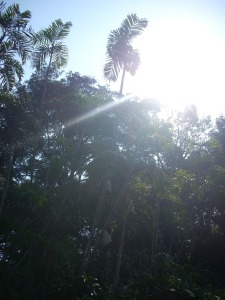
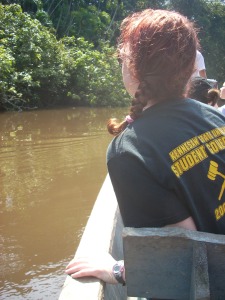
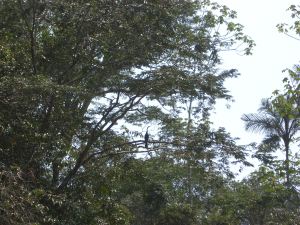
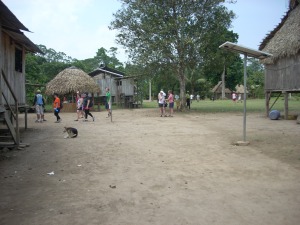
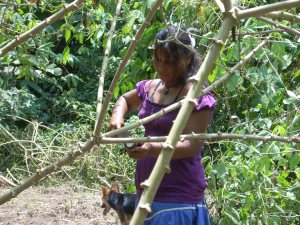
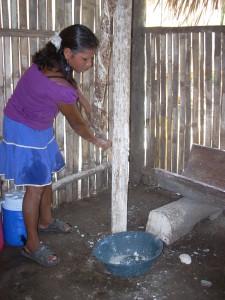
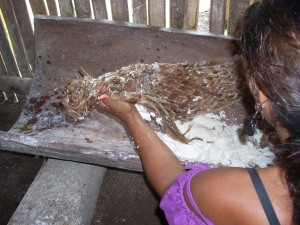
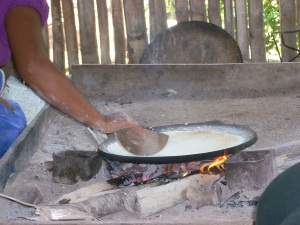
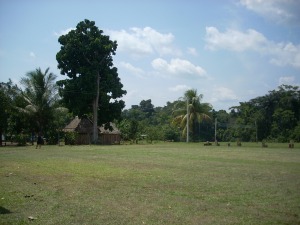




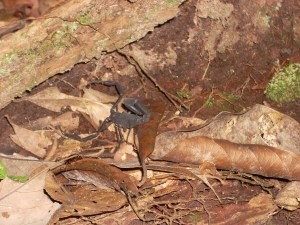
You go girl….Oh to be 20 something again!!! Live life to it’s fullest.
Love ya,
debbie
By: Debbie on February 27, 2010
at 1:34 am